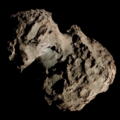28P/Neujmin
 Sketch of Comet Neujmin 1 as seen by Edward E. Barnard from the Yerkes Observatory on 9 September 1913. | |
| Discovery | |
|---|---|
| Discovered by | Grigory Neujmin |
| Discovery date | 3 September 1913 |
| Designations | |
| P/1913 R2, P/1931 S1 | |
| |
| Orbital characteristics[4][5] | |
| Epoch | 17 October 2024 (JD 2460600.5) |
| Observation arc | 110.58 years |
| Number of observations | 1,276 |
| Aphelion | 12.38 AU |
| Perihelion | 1.585 AU |
| Semi-major axis | 6.983 AU |
| Eccentricity | 0.77297 |
| Orbital period | 18.45 years |
| Inclination | 14.299° |
| 346.39° | |
| Argument of periapsis | 347.47° |
| Mean anomaly | 70.299° |
| Last perihelion | 11 March 2021[1][2] |
| Next perihelion | 23 July 2039[3] |
| TJupiter | 2.168 |
| Earth MOID | 0.574 AU |
| Jupiter MOID | 0.960 AU |
| Physical characteristics[4][6] | |
| Dimensions | 21.4 km (13.3 mi) |
| 12.75±0.03 hours | |
| 0.025 | |
| Comet total magnitude (M1) | 13.2 |
28P/Neujmin, also known as Neujmin 1, is a large periodic comet in the Solar System. With a perihelion distance (closest approach to the Sun) of 1.5 AU (220 million km), this comet does not make close approaches to the Earth.[4]
Orbital and physical characteristics
[edit]The comet nucleus is estimated to be 21.4 km (13.3 mi) in diameter with a low albedo of 0.025.[4] Since 28P has such a large nucleus, it became brighter than the 20th magnitude in early 2019, roughly 2 years before coming to perihelion. When it came to opposition in May 2020, when it was still 3.5 AU (520 million km) from the Sun, it had an apparent magnitude around 16.9. But during the 2021 perihelion passage the comet was on the opposite side of the Sun as the Earth. The comet is not known for bright outbursts of activity.
References
[edit]- ^ Seiichi Yoshida (7 September 2004). "28P/Neujmin 1". Seiichi Yoshida's Comet Catalog. Retrieved 26 February 2010.
- ^ Syuichi Nakano (1 May 2001). "28P/Neujmin 1 (NK 798)". OAA Computing and Minor Planet Sections. Retrieved 26 February 2010.
- ^ "Horizons Batch for 28P/Neujmin 1 (90000386) on 2039-Jul-23" (Perihelion occurs when rdot flips from negative to positive). JPL Horizons. Retrieved 2 May 2023. (JPL#74/Soln.date: 2023-Mar-29)
- ^ a b c d "28P/Neujmin 1 – JPL Small-Body Database Lookup". ssd.jpl.nasa.gov. Jet Propulsion Laboratory. Retrieved 25 February 2010.
- ^ "28P/Neujmin Orbit". Minor Planet Center. Retrieved 12 September 2021.
- ^ C. E. Delahodde; K. J. Meech; O. R. Hainaut; E. Dotto (2001). "Detailed phase function of comet 28P/Neujmin 1". Astronomy & Astrophysics. 376 (2): 672–685. Bibcode:2001A&A...376..672D. doi:10.1051/0004-6361:20011028.
External links
[edit]- 28P/Neujmin at the JPL Small-Body Database
- 28P at Kronk's Cometography
- 28P/Neujmin 1 – Seiichi Yoshida @ aerith.net


